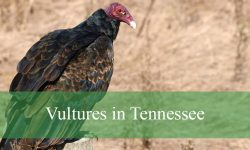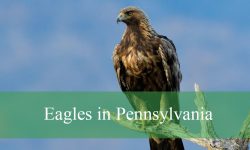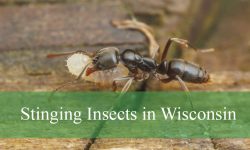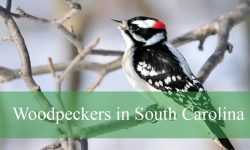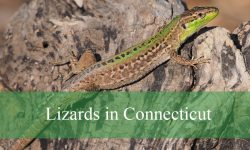Michigan is a prime destination for birdwatchers, offering a diverse range of habitats that attract numerous warbler species. From dense forests to wetlands, the state’s varied landscapes provide ideal stopovers for these colorful migratory birds.
Warblers in Michigan showcase an incredible array of plumage patterns, songs, and behaviors. Bird enthusiasts can spot everything from the striking Black-throated Blue Warbler to the rare and iconic Kirtland’s Warbler, each with unique traits that make identification a rewarding challenge.
This guide covers 38 types of warblers found in Michigan, complete with photos and key identification tips. Whether you’re observing during spring migration or exploring local woodlands, these insights will help you recognize and appreciate these vibrant birds.
Common Warblers Found in Michigan
American Redstart (Setophaga ruticilla)
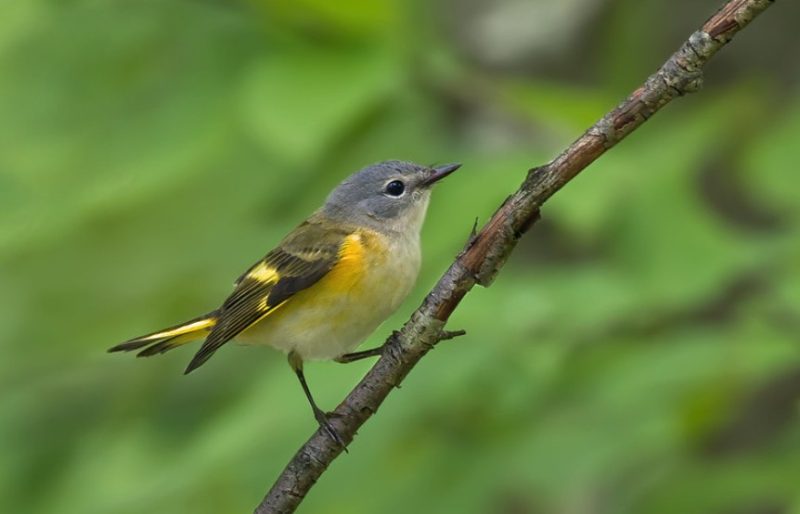
The American Redstart is one of the most striking warblers found in Michigan, recognized by its bold black plumage accented with vivid orange patches on the wings, sides, and tail in males. Females and young birds show a softer palette of gray and yellow, making them easier to distinguish. These small birds measure about 4.5–5 inches in length with a wingspan of 6.5–7.5 inches, giving them an agile appearance well-suited to quick movements through the trees.
Their behavior is highly energetic, often flicking their tails and wings to startle insects from foliage before darting after them midair. They thrive in second-growth forests, woodland edges, and shrubby areas, making Michigan’s diverse habitats perfect during the breeding season. Their distinctive “sneezy” song and rapid movements help birdwatchers identify them even at a distance.
A fun fact about the American Redstart is that it is sometimes nicknamed the “butterfly bird” because of its fluttery flight and colorful flashes, which resemble butterflies in motion. Males aggressively defend their territories, while females often choose sites near water to build their nests. Michigan is one of the prime breeding grounds for this species, especially in the Upper Peninsula.
Bay-breasted Warbler (Setophaga castanea)

The Bay-breasted Warbler is a handsome songbird distinguished by its chestnut-colored breast, throat, and sides during breeding season. Its head shows a rich chestnut crown bordered by a black face mask and olive-green nape, creating a striking combination. In non-breeding plumage, the bird looks more subdued with olive-green and pale tones, but it can still be identified by its unique wing bars. Adults measure about 5.5–6 inches in length with a wingspan of 8–9 inches.
These warblers are somewhat secretive compared to more active species. They prefer dense coniferous forests, particularly spruce and fir, which are abundant in northern Michigan. During migration, they are often seen in mixed flocks with other warblers, feeding on insects and berries. They are especially known for consuming spruce budworms, making them valuable allies in forest health.
A fun fact about the Bay-breasted Warbler is that it undergoes one of the most dramatic seasonal plumage changes among warblers, shifting from bright breeding colors to olive tones in fall. Birdwatchers in Michigan often prize sightings of this species, as its presence can indicate the health of local spruce forests.
Black-and-white Warbler (Mniotilta varia)

The Black-and-white Warbler is easily recognized by its bold zebra-like stripes that cover its body from head to tail. Unlike most warblers, this species creeps along tree trunks and branches like a nuthatch, probing bark for insects. They are small birds, measuring 4.3–5.1 inches in length with a wingspan of about 7–8 inches. Their black-and-white plumage makes them one of the easiest warblers to identify in Michigan.
In terms of behavior, these warblers are quite distinctive. They forage by spiraling around trees, using their slightly curved bills to pry insects from crevices. Their song is a high-pitched, squeaky series of notes often described as “wee-see, wee-see,” which carries well in wooded habitats. They thrive in mature deciduous and mixed forests throughout Michigan, especially in protected woodland areas.
A fun fact about the Black-and-white Warbler is that it is one of the earliest warblers to arrive in Michigan during spring migration. Because of its unique foraging style and year-after-year site fidelity, birdwatchers often find them in the same patches of forest season after season.
Blackburnian Warbler (Setophaga fusca)
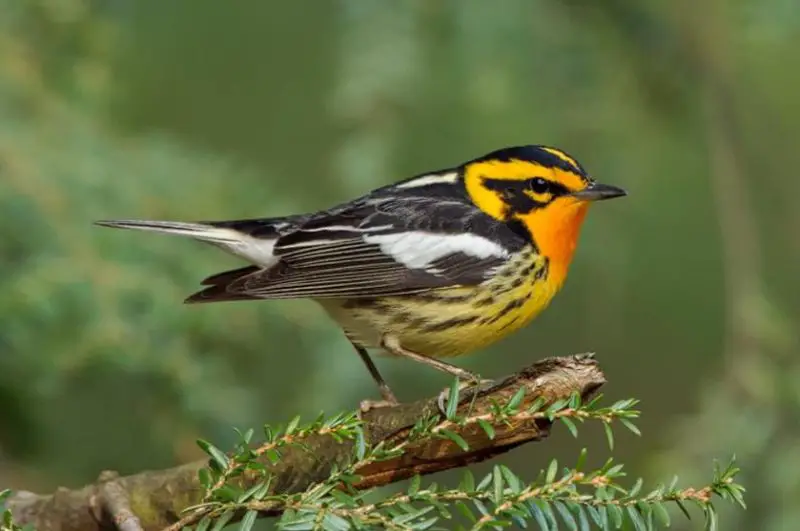
The Blackburnian Warbler is a fiery jewel among Michigan’s birds, famous for the blazing orange throat and face that set males apart. Their striking black upperparts with white wing patches and streaked sides enhance their brilliance. Females and immature birds are more muted, showing yellowish-orange throats and olive backs. They measure 4.7–5.1 inches long with wingspans of about 7.5–8.7 inches.
These warblers prefer the upper canopy of mature coniferous and mixed forests, making them somewhat challenging to spot. Their thin, high-pitched song often alerts birders before the birds are seen, as they flit high among the branches searching for insects. In Michigan, they breed widely in northern forests, especially where spruce and hemlock dominate.
A fun fact about the Blackburnian Warbler is that it is sometimes called the “flame-throat warbler,” thanks to its blazing orange plumage. Despite their bright colors, they can be surprisingly difficult to observe because they forage so high in the treetops. Their presence is considered a highlight of Michigan’s spring migration season.
Blackpoll Warbler (Setophaga striata)

The Blackpoll Warbler is a medium-sized warbler notable for its black cap, white cheeks, and streaked black-and-white body during breeding season. Outside the breeding period, its plumage turns more subdued olive-gray with faint streaking, making identification trickier. Adults are about 5.5 inches in length with wingspans around 8.5–9.1 inches, giving them a slim but sturdy look.
These warblers are best known for their incredible migration. In Michigan, they pass through in large numbers during spring and fall, often stopping in forests and shrubby areas to feed on insects and berries. They breed in northern boreal forests and migrate thousands of miles to South America for the winter. During migration, they can be seen in both rural and urban landscapes across the state.
A fun fact about the Blackpoll Warbler is that it undertakes one of the longest nonstop migratory flights of any songbird, traveling over 2,000 miles across the Atlantic Ocean in a single journey. For Michigan birders, catching sight of these small yet mighty travelers is always an inspiring moment.
Black-throated Blue Warbler (Setophaga caerulescens)
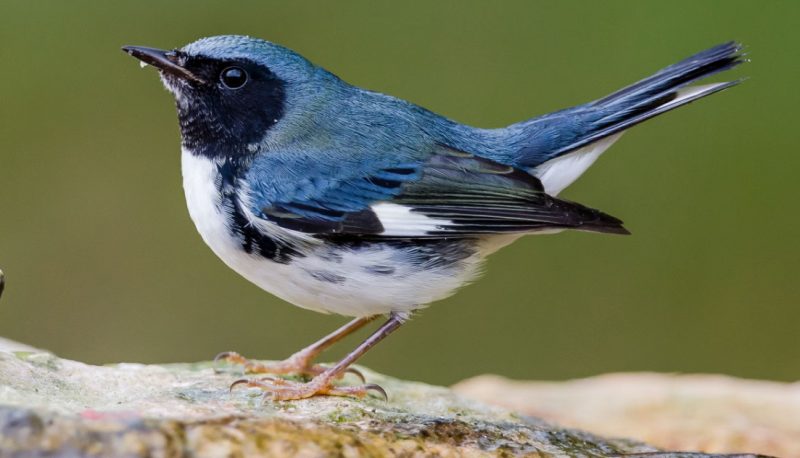
The Black-throated Blue Warbler is a striking species easily identified by the male’s deep blue back, black face and throat, and contrasting white underparts. Females, however, look quite different, sporting olive-brown plumage with a faint facial pattern and a distinct white patch on the wing that helps in identification. They measure 4.3–5.1 inches in length with a wingspan of 7.5–8.3 inches.
In Michigan, these warblers favor mature hardwood and mixed forests, particularly those with dense understory shrubs. Their behavior is less restless compared to other warblers, as they methodically forage for insects and spiders in the lower and mid-levels of the forest. Their song is a simple buzzy “zur, zur, zur-zee,” which can be a useful clue when trying to locate them.
A fun fact about the Black-throated Blue Warbler is that males and females look so different that early naturalists once thought they were separate species. They are especially tied to breeding habitats in Michigan’s northern forests, where their populations remain relatively stable compared to other declining warblers.
Black-throated Green Warbler (Setophaga virens)
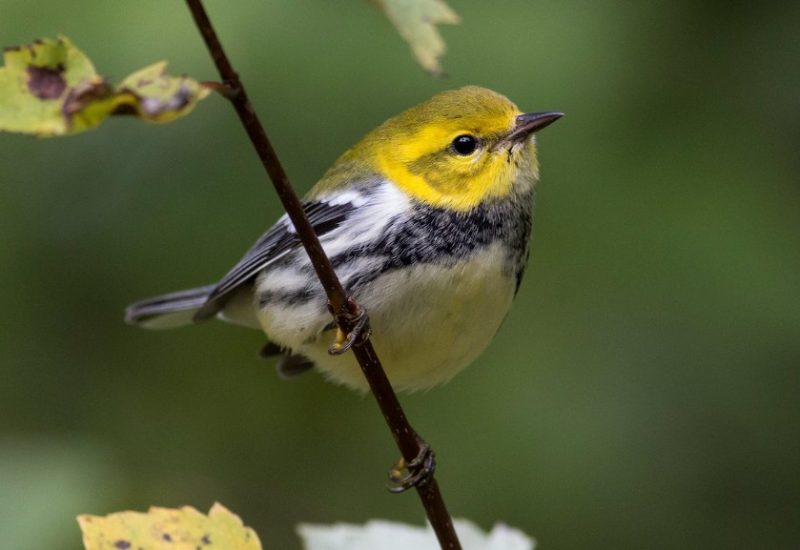
The Black-throated Green Warbler is a small but striking bird, easily recognized by its yellow face, olive-green back, and bold black throat and upper chest in males. Females and immature birds have more subdued markings but still show the characteristic yellow face that helps with identification. They measure about 4.3–5.1 inches in length with a wingspan ranging from 6.7–7.9 inches, making them a medium-sized warbler compared to others in Michigan.
This species prefers coniferous and mixed forests, especially hemlock stands and pine groves found throughout northern Michigan. They are active foragers, moving deliberately through branches in search of insects and spiders. Their song, often described as “trees, trees, murmuring trees,” is a distinctive buzzy phrase that carries well in the forest and is one of the easiest warbler songs to recognize.
A fun fact about the Black-throated Green Warbler is that it often hybridizes with the Townsend’s Warbler in parts of its western range, but in Michigan, pure Black-throated Greens are the norm. Their strong association with hemlock forests makes them an indicator species for the health of these ecosystems in the state.
Blue-winged Warbler (Vermivora cyanoptera)
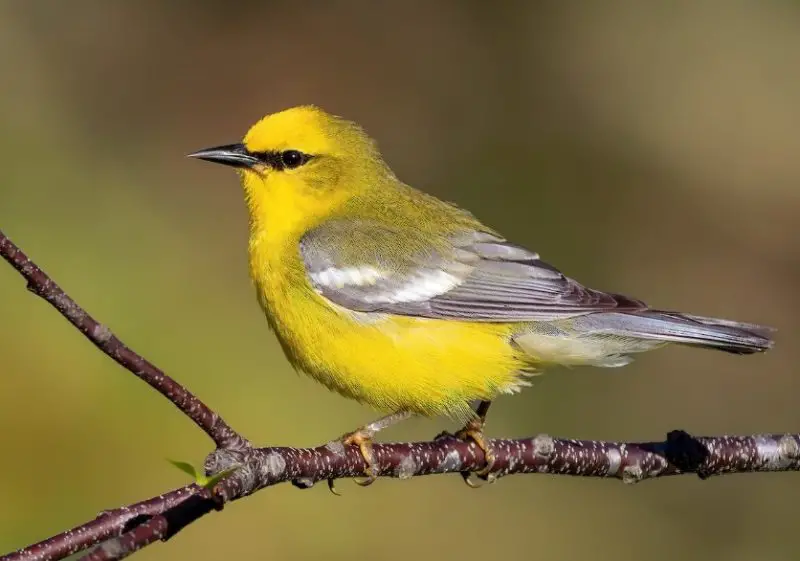
The Blue-winged Warbler is a bright and easily identified bird with its lemon-yellow body, pale blue-gray wings, and a thin black eye line that adds contrast to its face. Males and females are similar in appearance, though males tend to be brighter overall. These birds are about 4.3–4.7 inches long with a wingspan of 6.7–7.5 inches, giving them a slim and agile build.
They prefer shrubby fields, forest edges, and young regenerating habitats across Michigan, particularly in the southern part of the state. Their distinctive buzzy song, often described as “bee-buzz,” is one of the clearest ways to identify them even without a visual sighting. They spend much of their time flitting through low vegetation in search of insects and caterpillars.
A fun fact about the Blue-winged Warbler is that it often hybridizes with the Golden-winged Warbler, producing offspring known as Brewster’s and Lawrence’s Warblers. Michigan birdwatchers sometimes encounter these hybrids, making sightings of Blue-winged Warblers even more exciting and scientifically significant.
Canada Warbler (Cardellina canadensis)

The Canada Warbler is a late-spring migrant, easily identified by its bright yellow underparts, slate-gray back, and striking necklace of dark streaks across the chest. Its bold white eye ring gives it an alert, wide-eyed look. Measuring about 4.7–5.9 inches in length with a wingspan of 7.5–8.7 inches, it is slightly larger than many other warblers in Michigan.
This species prefers shady, damp forests with dense understory vegetation, particularly near streams and boggy areas. They are lively foragers, darting among shrubs and low branches in search of insects and often feeding closer to the ground than other warblers. Their song is a rapid, musical series of notes, adding energy to the forest soundscape during breeding season.
A fun fact about the Canada Warbler is that it is sometimes nicknamed the “necklaced warbler” due to its distinctive chest markings. In Michigan, it is considered a species of special concern because of habitat loss, making sightings especially prized among birders.
Cape May Warbler (Setophaga tigrina)

The Cape May Warbler is a colorful species known for the chestnut cheek patch and tiger-like streaking across its yellow breast. Males in breeding plumage are especially vivid, with olive backs, yellow rumps, and dark crown caps. Females and immatures are more muted but still show streaking on the breast. Adults measure about 4.3–5.1 inches in length with a wingspan of 7.5–8.7 inches.
This warbler breeds in northern coniferous forests, particularly in spruce stands, and migrates through Michigan in spring and fall. They are specialized feeders, using their slightly curved bills to sip nectar and consume spruce budworms, an important food source that ties them closely to boreal forests. In migration, they often visit flowering trees and even backyard gardens.
A fun fact about the Cape May Warbler is that its tubular tongue is uniquely adapted for sipping nectar, a trait uncommon among warblers. This adaptation allows them to thrive in both natural and human-altered landscapes during migration through Michigan.
Cerulean Warbler (Setophaga cerulea)

The Cerulean Warbler is a small, sky-blue bird admired for its delicate coloring and rarity. Males show a brilliant blue back, white underparts, and a narrow black band across the chest, while females are more greenish-blue with faint streaking. At just 4.3 inches in length and with a wingspan of 7.5–8 inches, it is one of the smaller warblers found in Michigan.
These birds prefer mature deciduous forests with tall canopies, where they forage high in the treetops for insects. Their buzzy, accelerating song is often the best way to detect them, as they tend to stay out of easy sight. In Michigan, they are more frequently found in southern woodlands during breeding season, but their populations are declining due to habitat fragmentation.
A fun fact about the Cerulean Warbler is that it has one of the steepest population declines of any North American songbird, making it a high conservation priority. Spotting one in Michigan is always a highlight for birdwatchers, as it often requires patience and keen listening skills.
Chestnut-sided Warbler (Setophaga pensylvanica)

The Chestnut-sided Warbler is named for the rich chestnut streaks along its flanks that stand out against its bright yellow crown, white underparts, and black-streaked back. Males in breeding plumage are especially vivid, while females and immatures are more subdued with olive tones. They are small, measuring 4.7–5.1 inches in length with wingspans of about 7.5 inches.
They thrive in shrubby habitats, forest clearings, and regenerating fields across Michigan, making them common in areas of young growth rather than mature forests. Their behavior is lively, and they are often seen flicking through low vegetation in search of caterpillars and other insects. Their song, often rendered as “pleased, pleased, pleased to meetcha,” is one of the most distinctive warbler tunes.
A fun fact about the Chestnut-sided Warbler is that it was once rare in the 19th century but became much more common as forests were cleared and regrowth habitats expanded. In Michigan, their adaptability makes them one of the more frequently observed warblers during breeding season.
Common Yellowthroat (Geothlypis trichas)
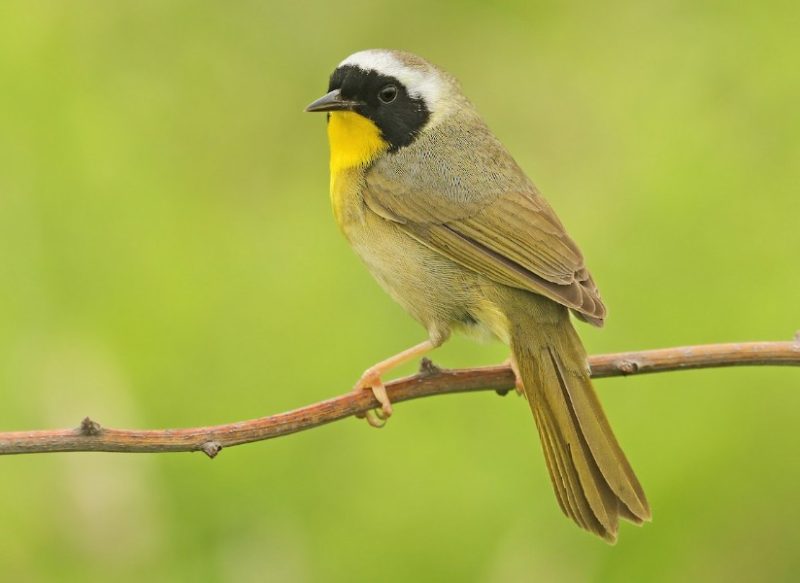
The Common Yellowthroat is one of the most widespread and easily recognized warblers in Michigan. Males are instantly identifiable by their bright yellow throat and chest, olive-green back, and distinctive black facial mask bordered by white. Females and immatures lack the mask and are plainer, with softer yellow underparts. They measure about 4.3–5.1 inches long with a wingspan of 5.9–7.5 inches.
This species thrives in wetlands, marshes, and shrubby thickets, making it one of the most adaptable warblers in the state. They are often seen flitting low among reeds and cattails, searching for insects, spiders, and caterpillars. Their song is a recognizable “witchety-witchety-witchety,” which rings out clearly in Michigan’s marshlands during the breeding season.
A fun fact about the Common Yellowthroat is that it is sometimes nicknamed the “marsh bandit” because of the male’s striking mask. Unlike many warblers that prefer forest habitats, these birds are happiest in low, dense cover, making them among the most frequently encountered warblers for Michigan birdwatchers.
Connecticut Warbler (Oporornis agilis)
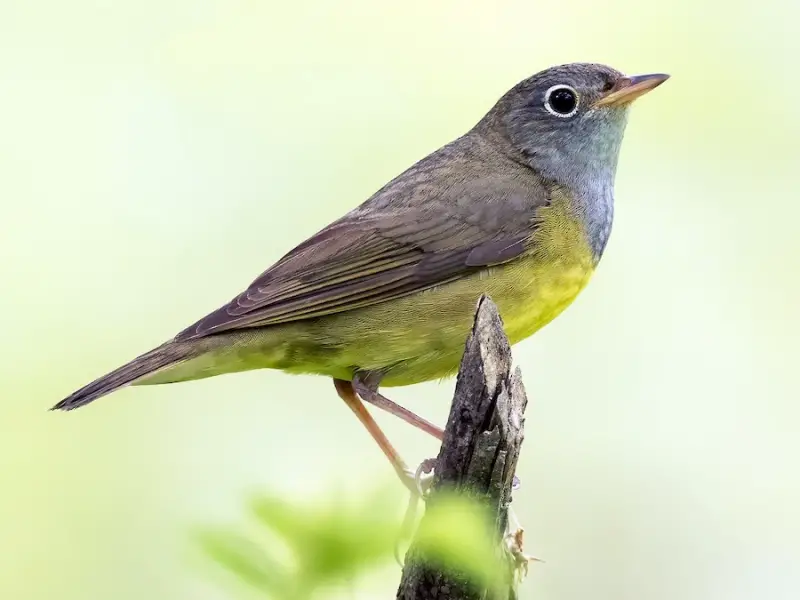
The Connecticut Warbler is a secretive and elusive species, making it one of the hardest warblers to spot in Michigan. Adults are olive-green above with a gray hood that covers the head and throat, paired with a bold white eye ring. They are relatively large for warblers, measuring 5.1–5.9 inches in length with a wingspan of 8.7 inches.
In Michigan, this warbler favors dense undergrowth in spruce and tamarack bogs, often staying hidden while foraging close to the ground for insects. Their behavior is quiet and deliberate, moving slowly through the vegetation rather than flitting about like other warblers. Their song is a loud, ringing series of phrases that carries surprisingly far through the forest.
A fun fact about the Connecticut Warbler is that Michigan is one of the best places to see this otherwise rare bird, as the state lies in the heart of its breeding range. Birders often travel from across the country hoping to glimpse this elusive species in the Upper Peninsula.
Golden-winged Warbler (Vermivora chrysoptera)
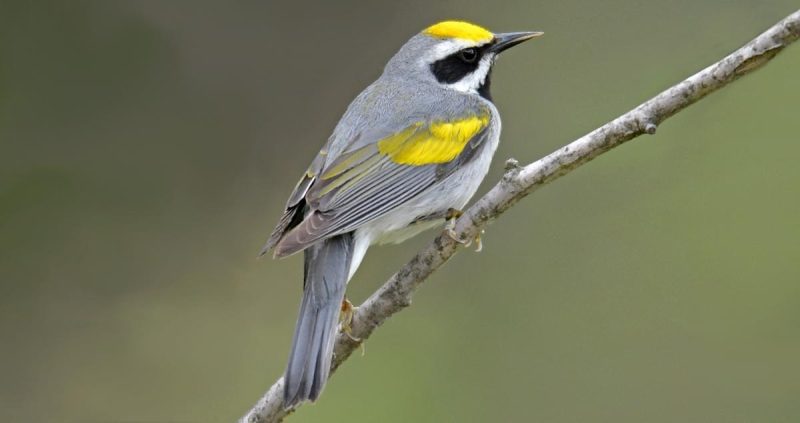
The Golden-winged Warbler is a striking bird with a gray body, bright yellow wing patches, a yellow crown, and a bold black-and-white facial pattern. Females have the same markings but in softer tones. These birds are small, measuring about 4.3–4.7 inches long with wingspans of 7.5–8 inches.
In Michigan, they prefer shrubby fields, forest edges, and regenerating woodlands with dense undergrowth. They forage actively in low vegetation, gleaning caterpillars, beetles, and other insects. Their buzzy song, often rendered as “bee-bzzz bzzz bzzz,” is a reliable way to detect their presence even when they stay hidden in thick cover.
A fun fact about the Golden-winged Warbler is that it is declining across much of its range due to habitat loss and hybridization with the Blue-winged Warbler. Michigan is an important stronghold for this species, and conservation efforts are focused on maintaining suitable shrubby habitats for its survival.
Hooded Warbler (Setophaga citrina)

The Hooded Warbler is a handsome bird recognized by the male’s bright yellow face and underparts, contrasted with a bold black hood and throat. Females lack the full black hood, appearing mostly yellow-green with a faint outline around the face. They are about 5 inches long with a wingspan of 6.9–7.9 inches, making them a medium-sized warbler.
These warblers prefer mature deciduous forests with dense understory in Michigan, often staying in shady thickets where they can forage for insects. Their behavior includes frequent tail flicking, which flashes their white tail spots as they move through the vegetation. Their song is a clear, ringing “ta-wit ta-wit ta-wit tee-yo,” often giving away their location before they are seen.
A fun fact about the Hooded Warbler is that it is known for its strong site fidelity, with males often returning to the exact same territory year after year. In Michigan, sightings are most frequent in the southern woodlands, where suitable dense forest understory still exists.
Kentucky Warbler (Geothlypis formosa)
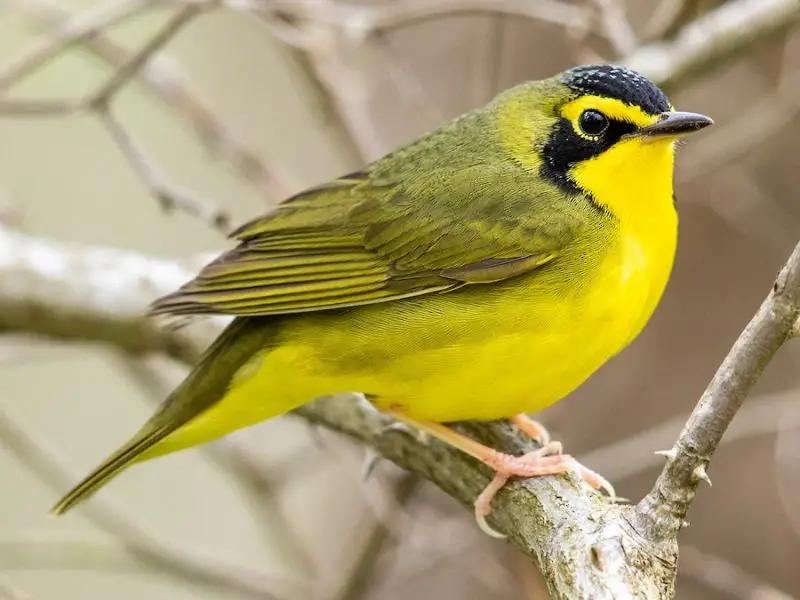
The Kentucky Warbler is a ground-dwelling species recognized by its bright yellow underparts, olive-green back, and bold black markings on the face that frame its yellow spectacles. Unlike many other warblers, it prefers staying close to the forest floor rather than foraging high in the canopy. These birds are relatively large, measuring about 5.1 inches long with a wingspan of 7.5–8.7 inches.
In Michigan, the Kentucky Warbler inhabits moist deciduous forests with thick understory growth. They are secretive and often difficult to observe, but their loud, ringing song, described as “turree, turree, turree,” helps birders locate them. They forage mainly for insects, spiders, and other small invertebrates in leaf litter and low shrubs.
A fun fact about the Kentucky Warbler is that it is more often heard than seen, thanks to its skulking habits. In Michigan, it reaches the northern limit of its breeding range, making any sighting especially rewarding for bird enthusiasts.
Kirtland’s Warbler (Setophaga kirtlandii)
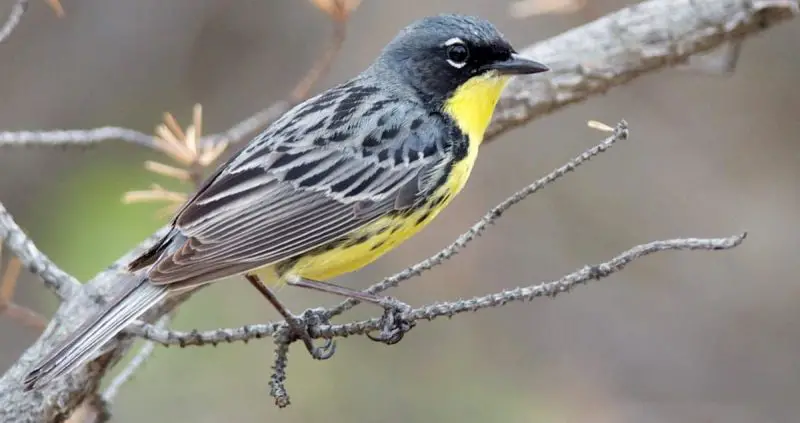
The Kirtland’s Warbler is Michigan’s most famous warbler, known worldwide for its rarity and strict habitat requirements. Males are striking with bluish-gray backs, black streaking, yellow underparts, and a bold black mask. Females are similar but duller, with less distinct markings. They are among the largest warblers, measuring 5.5–6 inches long with a wingspan of 8.7 inches.
This species breeds almost exclusively in young jack pine forests in Michigan, especially in the northern Lower Peninsula and parts of the Upper Peninsula. They forage on the ground and in low shrubs, feeding on insects, caterpillars, and berries. Their loud, ringing song carries across jack pine stands, making them easier to detect during breeding season despite their rarity.
A fun fact about the Kirtland’s Warbler is that it was once one of the rarest birds in North America, but thanks to conservation efforts in Michigan, its population has rebounded significantly. The bird remains a symbol of successful wildlife management and is a must-see species for birdwatchers visiting the state.
Louisiana Waterthrush (Parkesia motacilla)
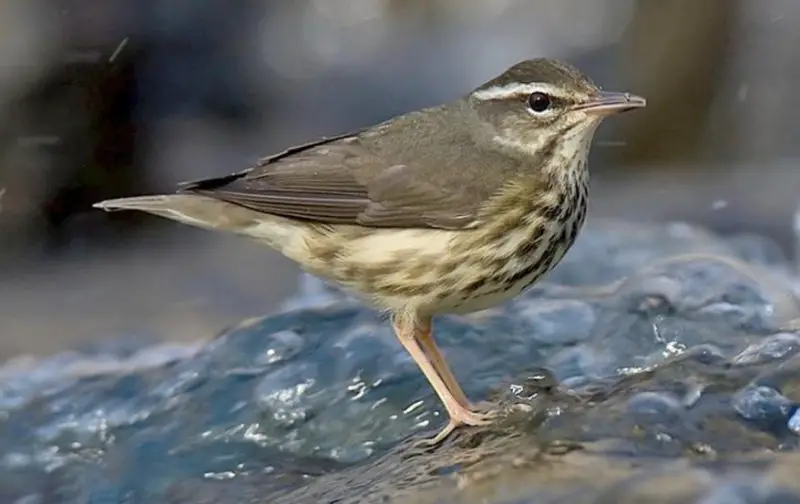
The Louisiana Waterthrush is a ground-dwelling warbler often found along fast-flowing streams and shaded creeks. Its brownish back, bold white eyebrow stripe, and streaked breast make it easy to distinguish from similar species. This bird constantly bobs its tail while walking along stream banks, a behavior that helps with identification.
During the breeding season, Louisiana Waterthrushes nest near water, often tucked into mossy banks or hidden among roots. Their sharp, ringing song carries through woodlands, signaling the presence of a territory. They are excellent insect hunters, darting after flies and beetles along the water’s edge.
A fun fact about this species is that despite its name, it is not a true thrush but a warbler. It earned its name because of its thrush-like appearance and preference for running water, which makes it unique among its relatives.
Magnolia Warbler (Setophaga magnolia)
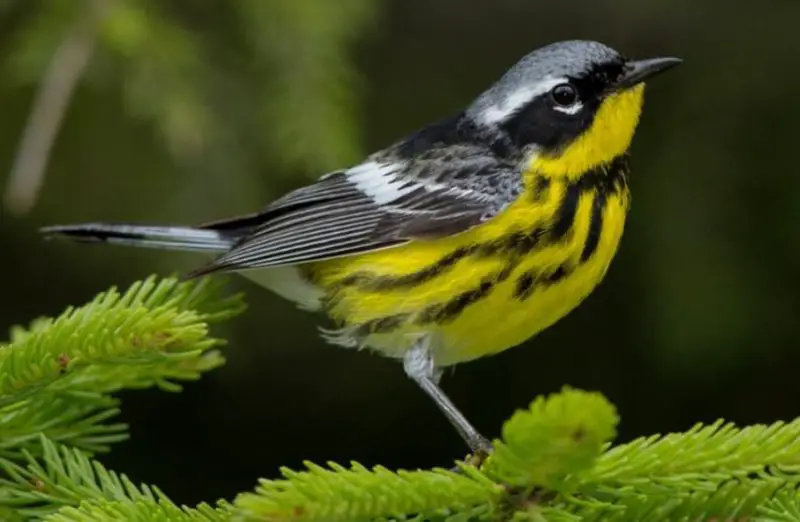
The Magnolia Warbler is a small, colorful songbird with striking black streaks across a bright yellow breast. Its gray back, white wing patches, and contrasting plumage make it a favorite among birdwatchers during spring migration. This species often flits among conifer branches, especially spruces and firs.
They breed in dense northern forests and pass through many states during migration. Their buzzy songs and energetic movements make them a lively presence in woodlands. Unlike some warblers, Magnolia Warblers often forage low in shrubs, giving observers a better chance of spotting them.
An interesting fun fact is that the first specimen was collected in a magnolia tree in Mississippi, which gave the bird its common name. However, the species does not have a special association with magnolias today, making the name a charming historical coincidence.
Mourning Warbler (Geothlypis philadelphia)
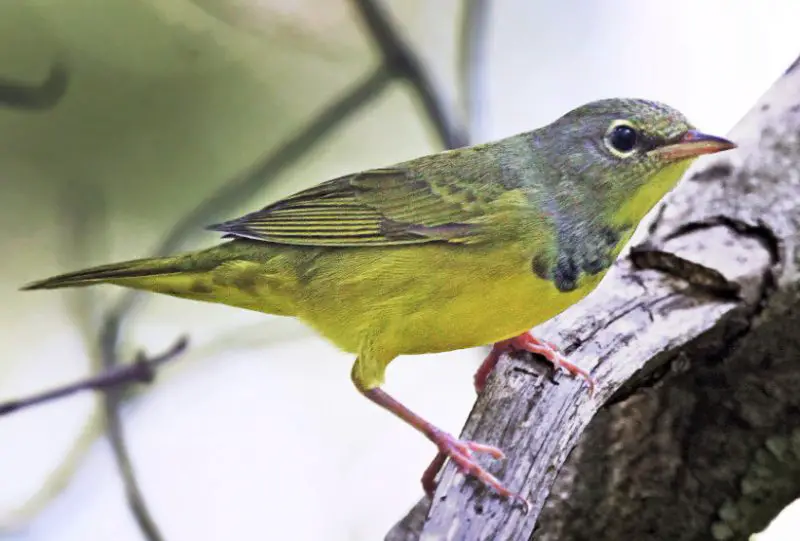
The Mourning Warbler is a secretive species recognized by its olive-green back, bright yellow underparts, and distinctive gray hood with a dark throat patch. Its name comes from the dark facial coloring that resembles the look of someone in mourning. These birds are much easier to hear than to see, as they often stay hidden in dense undergrowth.
They favor young forests, thickets, and regenerating clearings, where they search for insects close to the ground. Their clear, ringing song echoes through early summer habitats, but spotting one can be quite a challenge. Birders often rely on their unique vocalizations to confirm a sighting.
A fun fact about this bird is that it is considered one of the most elusive warblers in North America, and even experienced birdwatchers can go years without getting a clear look. Its preference for thick vegetation keeps it well hidden from predators and people alike.
Nashville Warbler (Leiothlypis ruficapilla)
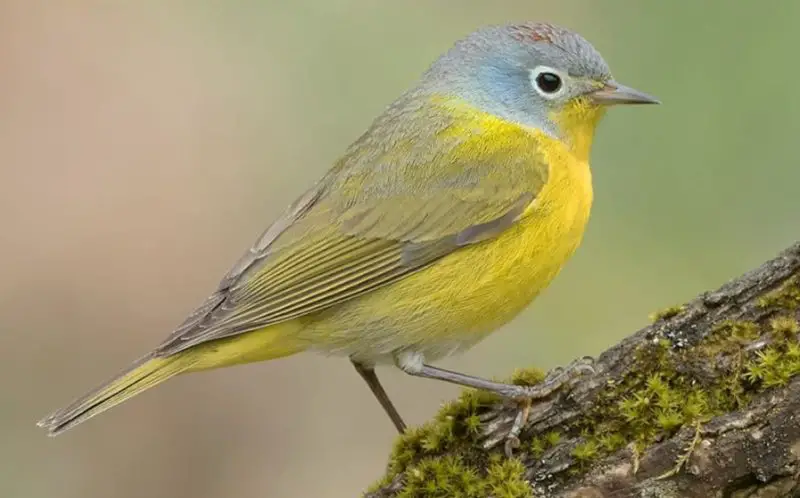
The Nashville Warbler is a small bird with a yellow belly, olive back, and a gray head. A hidden rufous crown patch, rarely visible, gives it extra charm. It is commonly found flitting through shrubs and trees during migration, especially in parks and open woodlands.
Despite its name, the Nashville Warbler does not breed in Tennessee. Instead, it was first recorded in Nashville during migration, which is how it got its name. Today, it breeds in northern forests and spends winters in Mexico and Central America.
A fun fact about the Nashville Warbler is that it often feeds by hanging upside down, gleaning insects from leaves like a tiny acrobat. This foraging style adds an element of playfulness to its behavior, making it enjoyable to watch during migration stops.
Northern Parula (Setophaga americana)

The Northern Parula is a small warbler with a beautiful mix of blue-gray upperparts, a yellow chest, and a green patch on its back. A chestnut band across its breast adds extra color in males. It is often seen flitting high in the canopy, especially in forests draped with Spanish moss or lichens.
This species breeds in eastern North America, where it prefers mature forests with plenty of epiphytes for nesting. Its rising, buzzy trill of a song is one of the first signs of spring in many regions, carrying a distinctive charm that birders eagerly anticipate.
A fun fact is that the Northern Parula almost disappeared from parts of the Southeast when Spanish moss declined due to air pollution and human activity. Thankfully, conservation efforts have helped preserve suitable habitats, allowing this colorful bird to continue thriving.
Northern Waterthrush (Parkesia noveboracensis)
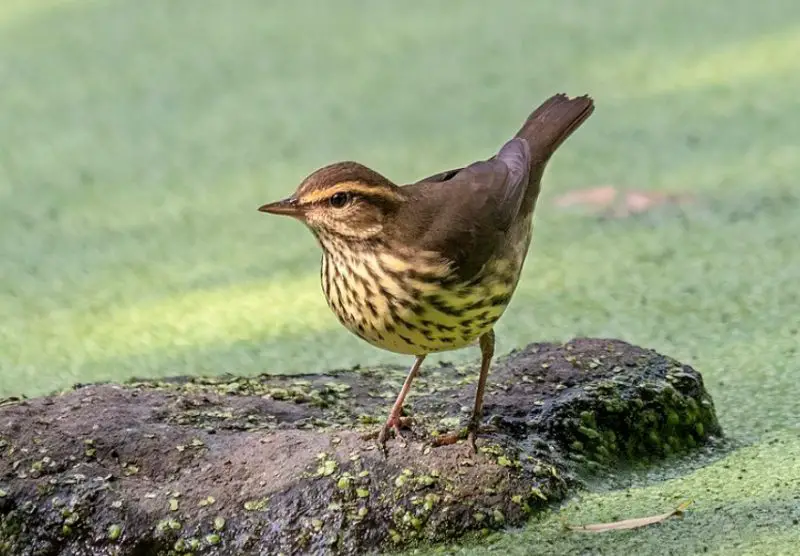
The Northern Waterthrush is a brown warbler with heavy streaking on its breast and a pale eyebrow stripe. Unlike many warblers, it prefers walking rather than flitting, often patrolling muddy edges of ponds, swamps, and streams. Its tail-bobbing behavior is a helpful clue for identification.
During migration, Northern Waterthrushes are among the earliest warblers to arrive and the last to depart. They breed in boreal wetlands and spend winters in tropical forests and mangroves, showing remarkable adaptability across regions. Their sharp, metallic call notes ring out frequently, especially when they are disturbed.
A fun fact about the Northern Waterthrush is that it can be found in mangrove swamps during the winter, making it one of the few warblers that regularly uses this unique ecosystem. This unusual habitat choice sets it apart from many of its relatives.
Orange-crowned Warbler (Leiothlypis celata)
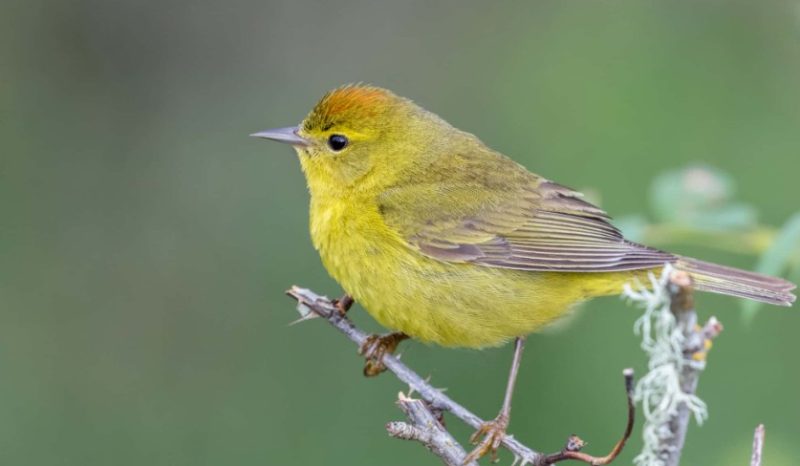
The Orange-crowned Warbler is a small, subtle warbler with olive-green upperparts and pale yellow underparts. Its name comes from the faint orange crown patch on males, which is often hidden and difficult to see. This species is widespread in Michigan during migration, often found in brushy fields, forest edges, and gardens.
It feeds actively in low shrubs and small trees, gleaning insects and spiders from leaves. Unlike many warblers, it is quiet and unobtrusive, making it easy to overlook despite its presence. Its song is a soft, trilled series of notes that blends with the surrounding foliage.
A fun fact about the Orange-crowned Warbler is that it is one of the first warblers to return to Michigan in spring, often arriving before many other species have left their wintering grounds, making it a subtle herald of the new season.
Ovenbird (Seiurus aurocapilla)
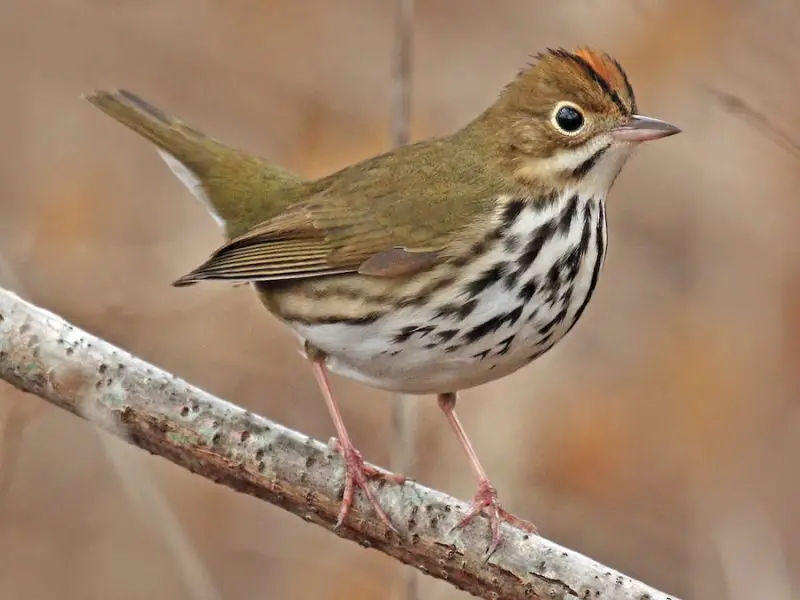
The Ovenbird is a medium-sized warbler with olive-brown upperparts, white underparts, and bold black streaks across its chest. Its name comes from the dome-shaped nest it builds on the forest floor, which resembles a traditional Dutch oven. It is common in Michigan’s deciduous forests, where its loud “teacher-teacher-teacher” song carries through the understory.
This species spends most of its time on the ground, walking and hopping in search of insects and spiders among leaf litter. Its skulking behavior makes it easier to hear than see, but careful observation can reveal its rapid movements through the forest floor.
A fun fact is that the Ovenbird’s unique nesting style provides excellent camouflage for eggs and young birds, helping them survive predation in dense forest habitats, which contributes to its success across Michigan woodlands.
Palm Warbler (Setophaga palmarum)

The Palm Warbler is a small warbler with olive-brown upperparts, yellow underparts, and a distinctive rusty cap. It is often seen flicking its tail constantly, a behavior that draws attention to its slender frame. In Michigan, it is most common during migration, stopping in open fields, forest edges, and wet meadows.
It forages actively on the ground and in low vegetation, feeding on insects, spiders, and berries. Its loud, musical trill is often heard before the bird is seen, helping birders locate this energetic species. Unlike many warblers, it is highly adaptable to various habitats during migration.
A fun fact about the Palm Warbler is that it spends more time on the ground than most warblers, earning the nickname “tail-bobbing warbler” because of its characteristic constant tail movement while searching for food.
Pine Warbler (Setophaga pinus)
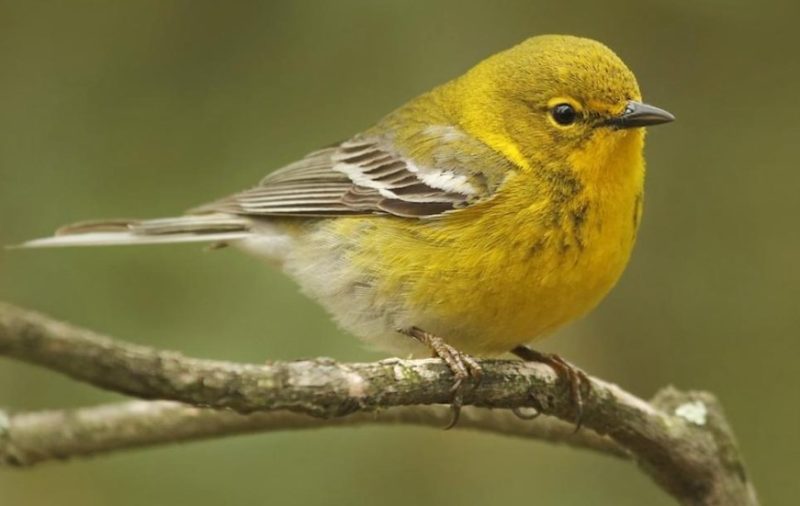
The Pine Warbler is a medium-sized warbler with olive-green upperparts, bright yellow underparts, and a subtle streaked chest. Males are brighter than females, and both sexes often show a hint of white wing bars. In Michigan, this species is strongly associated with pine forests, where it breeds and forages among the needles.
It is a versatile feeder, often climbing along branches and foraging high in pine trees for insects, seeds, and even pine sap. Its song is a cheerful trill that carries through the conifer canopy, helping birders detect its presence even when hidden.
A fun fact is that the Pine Warbler is one of the few warblers that can feed extensively on seeds in winter, allowing some populations to remain in the northern U.S. longer than most other migratory warblers.
Prairie Warbler (Setophaga discolor)
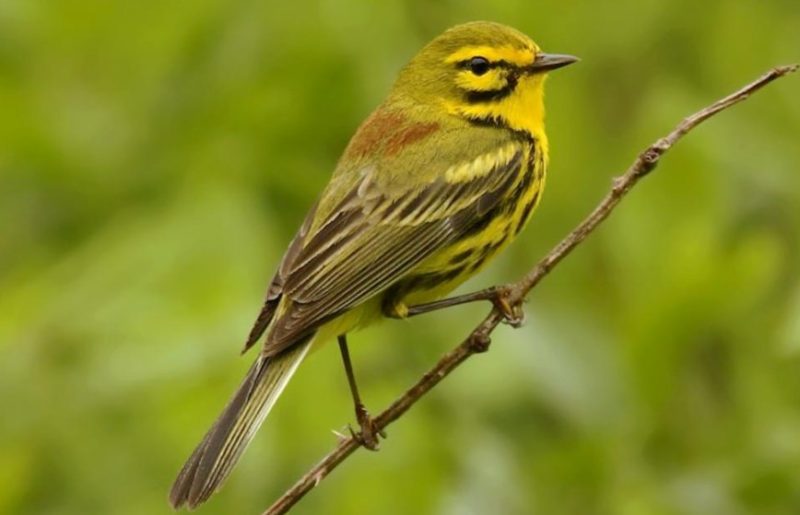
The Prairie Warbler is a small, bright warbler with yellow underparts streaked with black, olive upperparts, and bold black lines along its face and sides. Males are more vibrant than females, especially during the breeding season. In Michigan, it is a migrant species and a rare breeder, favoring shrubby fields, young forests, and open edges.
It is highly active, often moving rapidly among low shrubs while catching insects and spiders. Its song is a rising “zee-zee-zee-zoo-zee” that carries across open habitats, making it easier to detect than to see.
A fun fact about the Prairie Warbler is that its name reflects its historical association with open grasslands and prairies, even though it now thrives in young successional forests created by modern land use.
Prothonotary Warbler (Protonotaria citrea)

The Prothonotary Warbler is a striking golden-yellow warbler with blue-gray wings and tail, often called the “Swamp Canary” for its bright color and cheerful song. It prefers wet woodlands, swamps, and floodplain forests in Michigan, often nesting in cavities near water.
This species is highly territorial, and males sing loudly from prominent perches to defend breeding areas. They feed on insects, spiders, and small aquatic invertebrates, foraging in dense understory or along water edges. Their nesting habits include using natural cavities, nest boxes, or even discarded woodpecker holes.
A fun fact is that the Prothonotary Warbler is one of the few warblers that nest in tree cavities, a unique adaptation that helps protect their young from predators and flooding in wet habitats.
Tennessee Warbler (Leiothlypis peregrina)
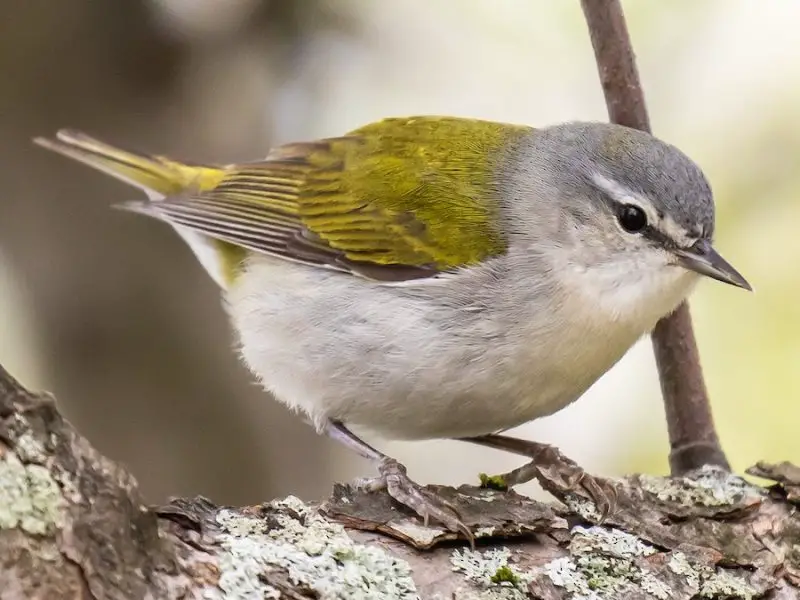
The Tennessee Warbler is a small, olive-green warbler with pale underparts and a subtle yellow wash on the chest. Its head appears slightly grayish, and the white eye-ring helps with identification. In Michigan, it is primarily seen during migration, flitting actively through forest edges and shrubby areas while foraging for insects.
It feeds mostly on caterpillars and other small insects, gleaning them from leaves and twigs, often moving rapidly and energetically. Despite its small size, its song—a rapid series of high-pitched notes—is surprisingly loud and carries through dense foliage.
A fun fact about the Tennessee Warbler is that it breeds far to the north in Canada and Alaska, traveling thousands of miles to reach its wintering grounds in Central America, making it one of the long-distance migrant warblers passing through Michigan.
Townsend’s Warbler (Setophaga townsendi)
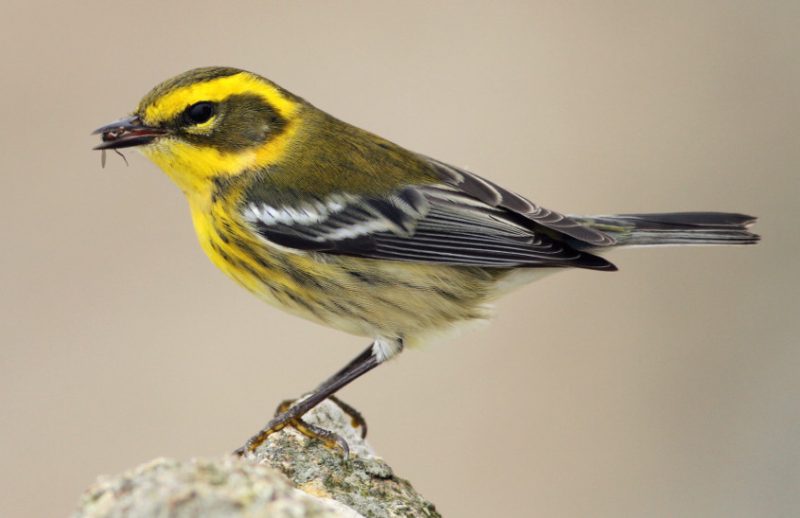
The Townsend’s Warbler is a striking species with black and yellow facial markings and olive-green upperparts. Males are more vividly colored than females, with a contrasting black throat and bold yellow patches. This warbler is considered rare in Michigan, mostly appearing during spring or fall migration.
It typically forages high in conifers, moving acrobatically among branches for insects and spiders. Its rapid, buzzing song helps alert birders to its presence despite its elusive behavior. Observing one in Michigan is a special treat because it is outside the bird’s normal range, usually confined to western North America.
A fun fact about Townsend’s Warbler is that vagrant individuals occasionally appear far east of their usual range, making Michigan a rare but exciting location for birdwatchers hoping to see this western species.
Wilson’s Warbler (Cardellina pusilla)
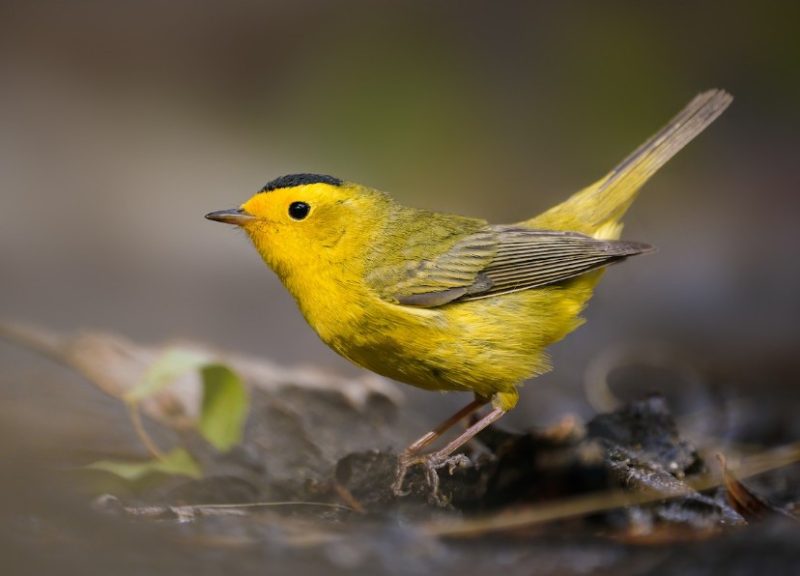
Wilson’s Warbler is a small, vibrant warbler with bright yellow underparts and a dark cap on the head, contrasting with olive-green upperparts. Males show a more distinct black cap than females, making identification easier during migration. In Michigan, they are primarily transient visitors in spring and fall.
These birds prefer shrubby thickets and dense vegetation near forest edges, actively foraging for insects in low foliage. Their constant movement and energetic feeding style make them lively to watch, and their sweet, trilled song is often the first clue to their presence.
A fun fact about Wilson’s Warbler is that, despite its bright colors, it is surprisingly difficult to see in dense cover, often making its presence known only through its cheerful song.
Worm-eating Warbler (Helmitheros vermivorum)
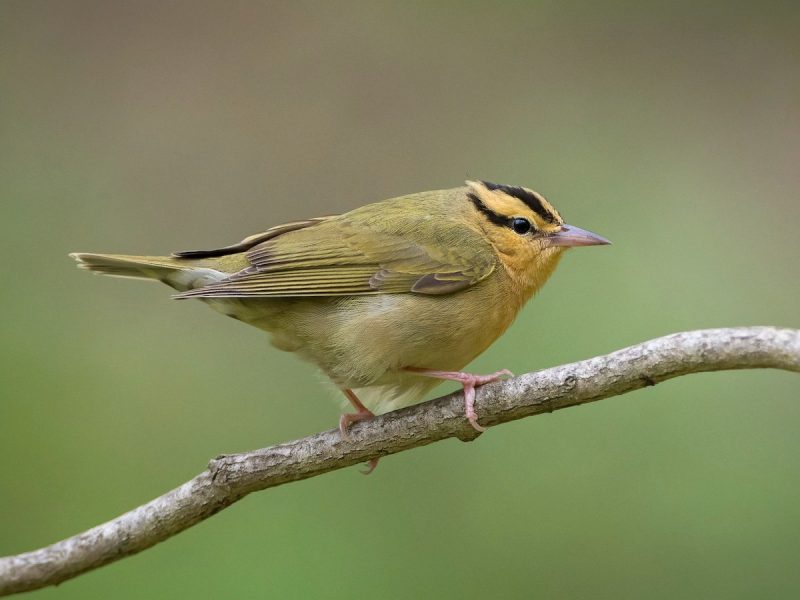
The Worm-eating Warbler is a secretive species with subtle brown and buff plumage, streaked underparts, and a dark crown stripe bordered by pale lines. In Michigan, it inhabits mature deciduous forests with thick leaf litter, where it forages on the forest floor for insects and spiders.
Unlike most warblers that feed in shrubs or trees, this species creeps along the ground, turning over leaves to uncover hidden prey. Its song is a soft, accelerating trill that can carry surprisingly far through the forest understory.
A fun fact about the Worm-eating Warbler is that its diet is heavily specialized for forest-floor invertebrates, earning it its name, and it rarely ventures into shrubs or higher vegetation like most warblers.
Yellow Warbler (Setophaga petechia)

The Yellow Warbler is one of Michigan’s most familiar warblers, with bright yellow plumage and reddish streaks on the chest. Males are slightly brighter than females, and both sexes are active foragers in shrubs, thickets, and wetlands. Their sweet, trilled song fills the air in spring and summer, making them easily detectable.
These birds are highly adaptable, nesting in a variety of habitats from wetlands to suburban gardens. They feed on insects and caterpillars, often flicking their wings as they search for prey. Their cup-shaped nests are usually placed low in shrubs or small trees.
A fun fact about the Yellow Warbler is that it sometimes covers parasitic cowbird eggs with fresh nest material to protect its own young, demonstrating a clever anti-parasitism strategy.
Yellow-breasted Chat (Icteria virens)
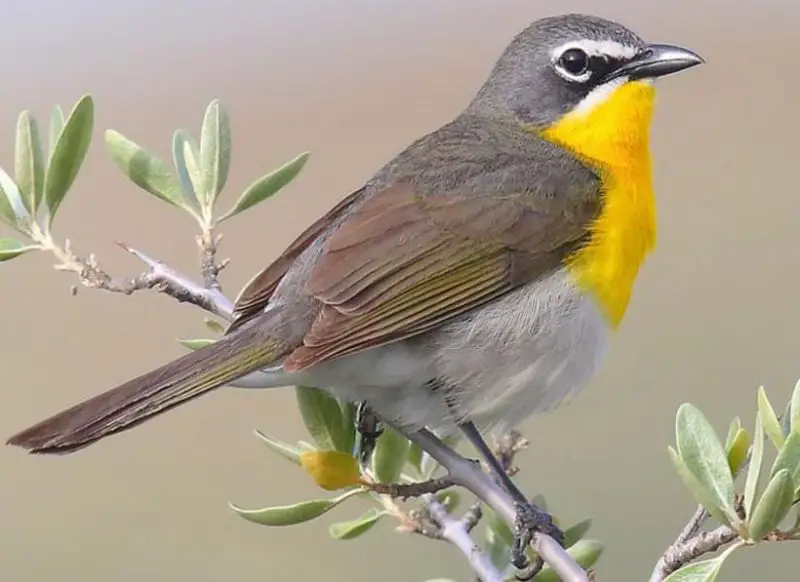
The Yellow-breasted Chat is a large, chunky warbler-like bird with bright yellow underparts, olive-green upperparts, and striking white spectacles around the eyes. In Michigan, it is more often heard than seen, frequenting dense tangles, shrublands, and forest edges during breeding and migration.
It feeds on insects and berries, foraging low in the vegetation while giving loud, varied calls and whistles that are unusual for typical warblers. Its bulky size and unique vocalizations distinguish it from smaller, more delicate warbler species.
A fun fact is that the Yellow-breasted Chat is sometimes grouped separately from warblers due to its size and behavior, earning it a special place in the hearts of birdwatchers looking for this uncommon but charismatic species.
Yellow-rumped Warbler (Setophaga coronata)
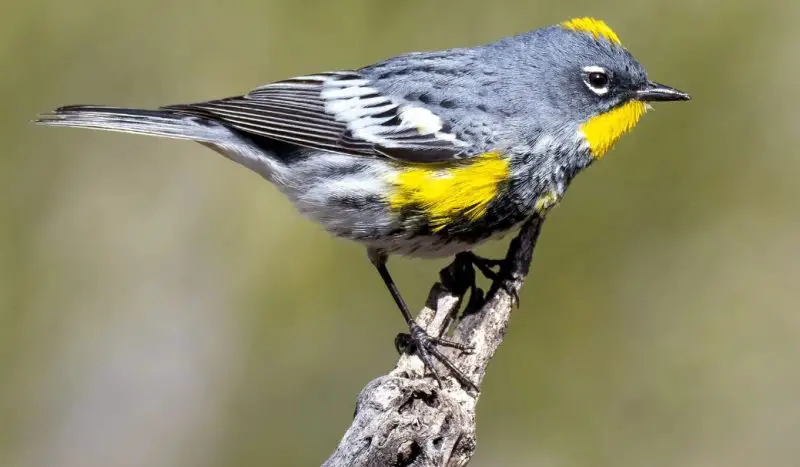
The Yellow-rumped Warbler is a versatile and widespread warbler in Michigan, recognized by its gray and brown plumage, white wing patches, and distinctive yellow rump. Breeding males have brighter yellow patches on the chest and sides, while females and immatures are duller but still show the yellow rump.
This species forages for insects, spiders, and berries both in trees and on the ground. It is often seen in mixed woodlands, shrubby areas, and during migration, in parks and suburban habitats. Its song is a buzzy trill that carries well in open areas.
A fun fact about the Yellow-rumped Warbler is that it is one of the few warblers able to digest bayberries and wax myrtle fruits, allowing it to overwinter farther north than most other warblers.
Yellow-throated Warbler (Setophaga dominica)
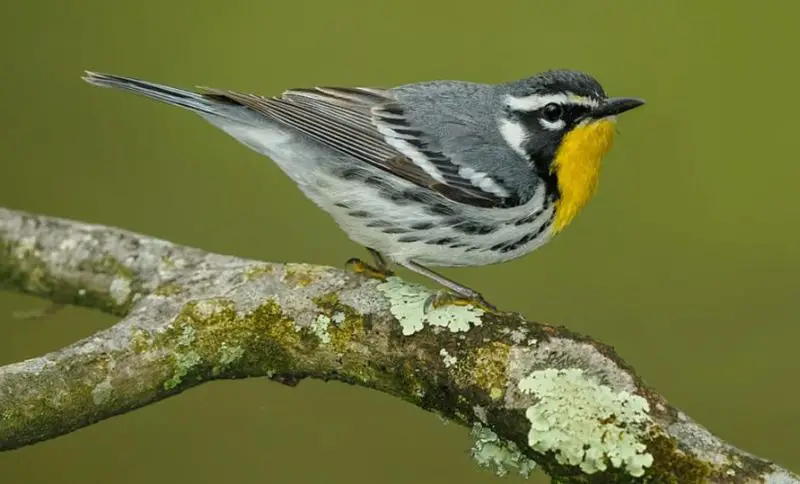
The Yellow-throated Warbler is a striking bird with a bright yellow throat, white belly, black-and-white streaked face, and gray upperparts. Males are highly visible in breeding areas, while females are slightly duller. In Michigan, it is a migrant and uncommon breeder in southern forests with tall pines and riverine habitats.
This species forages mainly in the upper canopy, gleaning insects and spiders from pine needles and branches. Its high-pitched, musical trill carries through forested areas, helping birders locate it despite its tendency to stay high above the ground.
A fun fact about the Yellow-throated Warbler is that it often nests in old woodpecker cavities in pine trees, an unusual adaptation for warblers that typically build open cup nests.
FAQs about Warblers in Michigan
What time of year can I see warblers in Michigan?
Warblers are mostly migratory birds in Michigan. Peak migration occurs in spring (April–May) and fall (September–October). Some species, like the Pine Warbler, may stay in Michigan year-round, but most only pass through during migration.
Where are the best places to spot warblers in Michigan?
Warblers prefer forests, woodlands, and wetlands. Popular birding spots include Huron-Manistee National Forests, Sleeping Bear Dunes, Pictured Rocks, and Shiawassee National Wildlife Refuge. Migrating warblers are often seen in parks and wooded trails.
How can I identify different warbler species?
Identification relies on plumage color, patterns, size, and song. For example, the Black-throated Blue Warbler has striking blue and black coloring, while the Common Yellowthroat has a distinctive black mask. Using a field guide or birding app can help distinguish similar species.
Are any warblers in Michigan endangered?
Yes, the Kirtland’s Warbler is a rare species that nests only in young jack pine forests. Conservation efforts have helped increase its population, but it remains a species of concern. Other warblers like the Cerulean Warbler are also declining due to habitat loss.
What do warblers eat?
Most warblers feed on insects, spiders, and other small invertebrates. Some species also eat berries and nectar, especially during migration or in winter. Providing native plants that attract insects can help warblers in your local area.
Can I attract warblers to my backyard?
Yes, planting native shrubs, trees, and flowering plants that provide food and shelter can attract warblers. Avoid pesticides and maintain a bird-friendly habitat. While warblers are more often seen during migration, some species like the Yellow-rumped Warbler may visit feeders.

